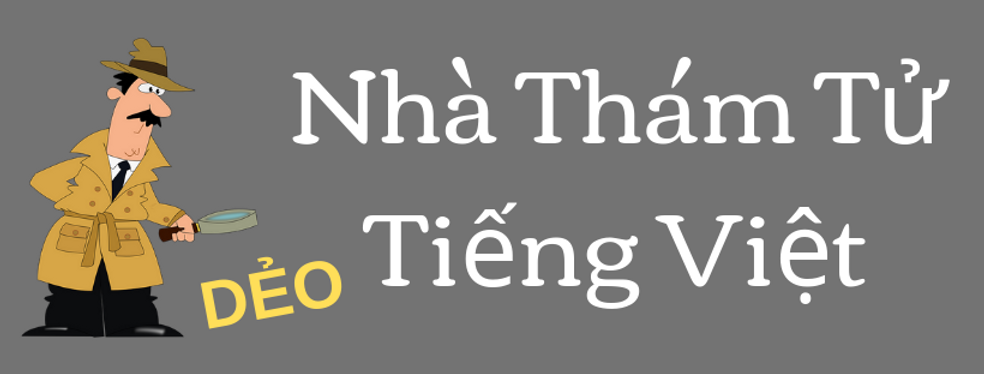Bạn có biết nghĩa của từ “động” không? “Động” xuất hiện trong những từ này.

Dựa vào những hình ảnh gợi ý, bạn đã biết nghĩa của từ “động” là gì chưa? (Đọc hết đi, để biết câu trả lời!) Như trong tiếng Anh, nếu bạn biết những từ gốc trong tiếng Việt, thì bạn có thể xác định ý nghĩa của từ dài mới. Chiều ngược lại, nếu bạn biết những từ có cùng gốc, thì bạn có thể xác định nghĩa của từ gốc đó. Việc này gọi là làm “Nhà thám tử” tiếng Việt.
Do you know the meaning of the Vietnamese word “động”? “Động appears in these words.
Based on the pictures, do you know the meaning of the word “động” yet? (Read to the end for the answer!) Just like in English, if you know a few root words, you can figure out the meanings of new, longer words. Conversely, if you know several words with the same root, you can figure out the meaning of that root. Figuring out the meaning of root words like this is the work of a “language detective.”
Khi tôi làm nhà thám tử ngôn ngữ, tôi để ý tìm những từ gốc mới trong những từ mà tôi học được hoặc tình cờ nhìn thấy được trong cuộc sống hàng ngày. Một lần, ở siêu thị tôi nhìn thấy hai thực phẩm này.

“Xoài dẻo” và “kẹo dẻo” có đặc điểm gì giống nhau? Cả hai thực phẩm này đều là đồ tráng miệng. Chắc “dẻo” có nghĩa là “ngọt.” Nhưng mà, tôi chưa chắc lắm. Tôi cần tìm thêm thông tin để xác nhận.
When I work as a language detective, I notice new roots in the words I study or that I see in everyday life. One time in the supermarket, I saw these two products. What characteristic do candied mango (xoài dẻo) and marshmallow (kẹo dẻo) have in common? Both of these products are desserts. Perhaps “dẻo” is another word for “sweet.” However, I’m not very certain. I will look for more information to confirm this.
Một vài ngày sau, trong khi tôi đang nấu cơm, tôi nhìn thấy một manh mối mới. Túi gạo của tôi là túi này.

Cơm trắng này “dẻo” mà không có vị ngọt. Cái gì giống với “xoài dẻo,” “kẹo dẻo,” và “cơm dẻo?” Tôi đã đoán, có lẽ “dẻo” là một phương cách sản xuất thực phẩm công nghiệp. Chắc là phương cách này được sử dụng để làm cả ba thực phẩm này. Tôi sắp nghiên cứu xong, nhưng nhà thám tử này cần một ví dụ nữa.
A few days later, while I was cooking dinner, I saw a new clue. This is the rice bag I was using. This rice is described as “dẻo” but it is not sweet. What else could be the same among candied mango, marshmallows, and this “dẻo” rice. I guessed that “dẻo” is a method of industrial production. Perhaps the same “dẻo” method is used to make all three products. I’m almost finished my investigation, but this detective needs just one more example.

Thứ 7 tuần trước tôi đi dạo xung quanh hồ. Một chiếc xe đạp bán hàng phát đi phát lại “Ép dẻo. Ép dẻo.” Tôi quay lại và nhìn thấy xe này. Tôi bước đến gần để xem, nhưng mà người thợ không bán đồ ăn gì cả. Xe đạp của anh ấy chỉ có ví và dây lưng. Manh mối này khiến tôi rất bối rối. Tôi về nhà để nghĩ tiếp, nhưng nghĩ mãi tôi cũng không thể nào nghĩ được từ “dẻo” thực sự có nghĩa là gì.
Last Saturday, I was going for a walk around my lake. A bicycle speaker kept repeating, “Ép dẻo. Ép dẻo.” I turned my head to see this. I stepped closer, but the vendor was not selling any food at all. The bicycle only had wallets and belts. This clue made me very confused. I returned home to keep thinking, but I just couldn’t think of what the meaning of “dẻo” could be.
Cuối cùng từ “dẻo” thắng nhà thám tử này. Tôi không biết “xoài dẻo,” “kẹo dẻo,” “cơm dẻo,” và “ép dẻo” kết nối với nhau thế nào. Tôi từ bỏ việc này và hỏi cô giáo của tôi. Cô ấy bảo “dẻo” có nghĩa là “dễ uốn.” Giống như ở chương cuối của quyển sách huyền bí, tất cả thắc mắc đã được giải đáp. Xe đạp “Ép Dẻo” có máy ép ở trên. “Ép dẻo” và “ép nhựa” có cùng nghĩa – bảo vệ một lá giấy bằng nhựa dẻo.
In the end, the word “dẻo” defeated this language detective. I don’t know what connects “xoài dẻo,” “kẹo dẻo,” “cơm dẻo,” and “ép dẻo”. I gave up and asked my teacher. She told me that “dẻo” means “flexible” or “stretchy.” Just like in the final chapter of a mystery novel, all the questions are resolved. The “Ép Dẻo” bicycle had a plastic laminator on top. The “dẻo” referred to the flexibility of the paper once it is laminated.

Nhà thám tử đã rất cố gắng để hiểu được từ “dẻo.” Lần này tôi đã thua rồi. Chắc là bạn có nhiều may mắn hơn. Nếu bạn đã xác định một từ mới nào đó bằng những từ xung quanh, thì viết một comment cho tôi biết về từ đó nhé. Những ai đọc hết được bài này thì sẽ biết nghĩa của từ “động” thôi!
As a language detective, I tried really hard to understand “dẻo”. This time I lost. Perhaps you will have more luck. If you have figured out a new word from the context words around it, then write about it in the comments below. Oh, and “động” means “active” or “in motion.”





